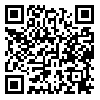Volume 21, Issue 1 (March 2023)
Iranian Rehabilitation Journal 2023, 21(1): 147-156 |
Back to browse issues page
1- Department of Occupational Therapy, Rehabilitation Research Center, School of Rehabilitation Sciences, Iran University of Medical Sciences, Tehran, Iran.
Abstract: (1090 Views)
Objectives: The patient evaluation measure (PEM) evaluates the hand health profile. Having an appropriate measurement tool for the assessment of hand outcomes in Iranian individuals with wrist disorders is essential for clinical and research settings. The objective of the present study was to examine the psychometric features of the PEM in Iranian individuals with wrist disorders.
Methods: Ninety individuals with wrist disorders were recruited. Hand outcome was evaluated with the PEM, quick-disabilities of the arm, shoulder, and hand (Q-DASH), visual analogue scale-pain (VAS-P), and JAMAR hand-grip dynamometer. The PEM was translated into Persian. Face, content, and convergent validity was examined. Also, acceptability, internal consistency, test-retest reliability, and absolute reliability were calculated.
Results: All questions had an item impact score and CVR score of >1.5 and >0.42, respectively. All questions except for question 1 (CVI=0.76) and 10 (CVI=0.73) of section B had a CVI score of <0.79. After changes were applied, the CVI score for these questions (question 1=0.83; question 10=0.87) reached acceptable criteria. The total score of the PEM showed a significant moderate correlation with Q-DASH (ρ=0.51; P<0.001) and VAS-P (ρ=0.55; P<0.001) and an insignificant weak correlation with grip strength (ρ=-0.11; P>0.05). Floor and ceiling effects were 0% for the total PEM score. The Cronbach’s α and intra-class correlation values were 0.72-0.87 and 0.96-0.98, respectively.
Discussion: The present study suggests that the PEM has acceptable validity and reliability for measuring performance and satisfaction in individuals with wrist disorders. This measure might contribute as an outcome measure in research and routine assessments in clinical practice.
Methods: Ninety individuals with wrist disorders were recruited. Hand outcome was evaluated with the PEM, quick-disabilities of the arm, shoulder, and hand (Q-DASH), visual analogue scale-pain (VAS-P), and JAMAR hand-grip dynamometer. The PEM was translated into Persian. Face, content, and convergent validity was examined. Also, acceptability, internal consistency, test-retest reliability, and absolute reliability were calculated.
Results: All questions had an item impact score and CVR score of >1.5 and >0.42, respectively. All questions except for question 1 (CVI=0.76) and 10 (CVI=0.73) of section B had a CVI score of <0.79. After changes were applied, the CVI score for these questions (question 1=0.83; question 10=0.87) reached acceptable criteria. The total score of the PEM showed a significant moderate correlation with Q-DASH (ρ=0.51; P<0.001) and VAS-P (ρ=0.55; P<0.001) and an insignificant weak correlation with grip strength (ρ=-0.11; P>0.05). Floor and ceiling effects were 0% for the total PEM score. The Cronbach’s α and intra-class correlation values were 0.72-0.87 and 0.96-0.98, respectively.
Discussion: The present study suggests that the PEM has acceptable validity and reliability for measuring performance and satisfaction in individuals with wrist disorders. This measure might contribute as an outcome measure in research and routine assessments in clinical practice.
Article type: Original Research Articles |
Subject:
Occupational therapy
Received: 2022/06/4 | Accepted: 2022/12/21 | Published: 2023/03/1
Received: 2022/06/4 | Accepted: 2022/12/21 | Published: 2023/03/1
| Rights and permissions | |
 |
This work is licensed under a Creative Commons Attribution-NonCommercial 4.0 International License. |





